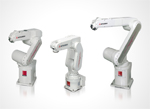5 September 2013
University uses Mitsubishi Electric robot to develop next generation robots
 Roboticists working at one of the world’s leading research centres are being helped in their development projects by a Mitsubishi Electric industrial robot.
Roboticists working at one of the world’s leading research centres are being helped in their development projects by a Mitsubishi Electric industrial robot.
Engineers, scientists and mathematicians in the Centre for Robotics Research (CoRe) at Kings College London are working on a number of different projects, each designed to take robot technology forward. Their time horizon is 25 years or more; the idea is not so much small scale improvements to existing technologies but the foundation of fundamentally new solutions – sometimes to problems that have yet to arise! To do this they set up test rigs with state of the art robots and try to develop new functions and capabilities.
One of its busiest test rigs is based on the RV3SD one of the latest Mitsubishi Electric industrial robots, which is designed to offer high performance and reliability to address demanding applications across many industries. Utilising Mitsubishi’s own servo and motion technologies the robot provides the speed, precision, power and repeatability required for reliable testing and development projects.
Many of the Centre’s projects require the handling of large amounts of complex data. The researchers find that Mitsubishi’s programming, modelling and diagnostic software are intuitive to use and powerful enough to cope, thus making the experiments easier to execute.
Professor Maria Fox explains the Centre’s strategic direction: “Today’s robots are very impressive, especially when you consider how quickly they have developed since the first generation of the technology. We can now foresee the imminent achievement of a significant developmental goal, the ability to integrate multiple tasks of very different natures.
“For instance, if you define washing up as manipulating dirty crockery through hot soapy water, today’s robots can do that. But if you add in all the associated tasks - identifying crockery amongst other items, handling appropriately (for size, delicacy, slipperiness etc), changing the water, adding soap, checking for post-washing cleanliness, stacking, drying and putting away - we need a new far more versatile robot. This is what we are aiming at with our current development programmes.
“Additionally, if you then want your washing up robot to tidy the living room, vacuum the stairs, make the beds, walk the dog and check that the kids are OK, you’ll need another 50-100 years of development!”
The Centre's research activities deal with a broad range of topics, covering: industrial automation; surgery, rehabilitation and medical devices; handling and manipulation; kinematics and mechanisms; sensing, monitoring and inspection; neural, cognitive and biomimetic systems. It is also keen on developing robots as art installations, having recently collaborated with the Bartlett School of Art on a robot installation at the Tate Modern.
Kaspar Althoefer, Professor of Robotics and Intelligent Systems and Head of the Centre, says that some of the hardware associated with robots is already well developed and mature.
“It is difficult to improve upon the mechanics of a robot arm like the RV3SD. It performs its required functions very well, offering multiple axes of motion or ‘degrees of freedom’ and fulfills defined needs.”
However there are other robot mechanisms – such as hands - that are in their infancy.Today’s hands tend to have rigid palms; their fingers are not fully autonomous and there is far too little real-time feedback on gripping pressure and friction with the object being held.
“We have several hands in development that mimic far more closely the abilities of a human hand - and we can foresee them, say, peeling an orange or making accurate origami models.”
If you watch a person performing such tasks, it is notable that it is not just one hand that is moving. Usually two hands work in unison, and this requires that the arms are also performing synchronised and coordinated movements. Again the Centre is at the cutting edge of understanding this and Mitsubishi control technology is providing the data processing power. Such functions require the coordination of both hands, both wrists, and all the major joints of the arms; they also need data from multiple feedback sensors to be analysed and interpreted in fractions of a second so that real-time decision making becomes possible.
Mitsubishi has long recognised that sensor-based feedback enables direct interactive control of robot movements, so has been able to develop robots that are capable of assessing incoming data and determining appropriate responses immediately. Its new CRD series of robot controllers come with an option to integrate the robot control system directly with the iQ controller platform. Because this removes the need to have a dedicated communications network between the controller platform and the robot controller, the system is inherently faster and more reliable, allowing millisecond response to sensor readings. The robot controller can analyse signals from ultrasonic, infrared and laser proximity sensors, cameras and force/torque sensors, and then plan the robot movements accordingly.
The system also incorporates collision avoidance, object identification and multi-dimensional decision making etc. Professor Althoefer again: “Our areas of research interest include robot motion planning, programming, modelling and control. These problems are easily tackled by humans but for robots, represent a mountain of high speed dynamic data processing. Algorithms for mobile robot motion planning are being developed by our teams to cope with cluttered environments, reversal manoeuvres, moving objects and other problems.
“We are also looking at the kinematics and dynamics of robot manipulators, neuro-fuzzy navigation for mobile robot and many other fields. “One of the common denominators in our work for many years to come will be steadily increasing the ability to absorb vast amounts of incoming real-time data, process it and make appropriate decisions about how the robots react. One of the long-term goals is to create robots that behave similarly to humans and can interact with humans in a natural way.”
- Contact Information
- Name: Wayne Hipkiss
- Email: sales@worldmc.co.uk
- Website: www.worldmc.co.uk

